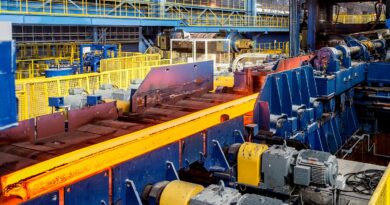VANADIUM USE: Steel still dominates, but batteries rising
Historically, vanadium demand has tracked closely with industrial output and infrastructure spending, particularly in emerging markets. The main drivers:
- global steel production, led by China
- chemical catalysts, particularly sulfuric acid and maleic anhydride
- and, increasingly, vanadium flow batteries
Historically, vanadium price has tracked closely to industrial output and infrastructure spending.
And global steel demand is not slowing down. Demand is expected to increase from 1.8 billion tons in 2020 to approx 2 billion tons in 2030, an average annual growth rate of around 1.06% or 11% in absolute terms compared with 2020 — driven by industrialization in developing countries such as India and regions in Africa.
In 2023, 94% of vanadium consumption in the US was still tied to steel alloying applications, with demand jumping 27% year-on-year. Between 2019 and 2023, total apparent consumption in the US grew by more than 40%, from under 10,000 metric tons to over 14,000.
In September 2024, China introduced new rebar standards that are expected to boost demand high-quality vanadium, potentially increasing vanadium nitrogen consumption by an estimated 15%. However, with a weak construction market and fragile economy in China, this may only offset industry wide falls.
Instead, it is new demand from the vanadium flow battery market that is expected to squeeze the underlying supply fundamentals.
The cumulative global demand of VRFB by 2030 is around 111 GWh, with annual demand of about 27 GWh, or 2.4% of the total required stationary storage capacity for that year — a CAGR of 41% from 2022 to 2030 — according a a World Bank Group report.
China is expected to drive the sector and recently announced a new production target for VRFBs, aiming to reach a 12 GWh annual capacity by 2027, but the move is global:
- in China, Rongke Power completed a 175MW/700MWh VRFB project, the largest of its kind globally, in 2024
- in Japan, Sumitomo Electric deployed a 51MWh VRFB system in Hokkaido to support wind energy integration, in 2022
- in Canada, Invinity Energy Systems is supplying an 8.4MWh VRFB for a solar-plus-storage project in Alberta
BloombergNEF predicts that, if all the redox flow batteries were grouped, the annual demand could compete with lithium-ion for up to 69 GWh capacity in 2030.
According to the World Bank report “Minerals for Climate Action: The Mineral Intensity of the Clean Energy Transition” vanadium demand could increase by 200% by 2050.
Without any significant new supply coming online CRU analysis expects the vanadium market to be in deficit after 2025.
Experts are estimating a global supply deficit in 2025 due to change in rebar standards and rise in vanadium battery demand, causing vanadium prices to rise. As more supply comes online in 2026 and 2027, by 2027 vanadium prices will come down when compared to 2025 prices, but crucially remain higher than the pricing in the last 12 months.
However, a significant challenge to such growth expectations for VRFB, is the scaling up of production from the current low levels of mining and refining, as well the high cost and limited manufacturing facilities for redox flow batteries.




